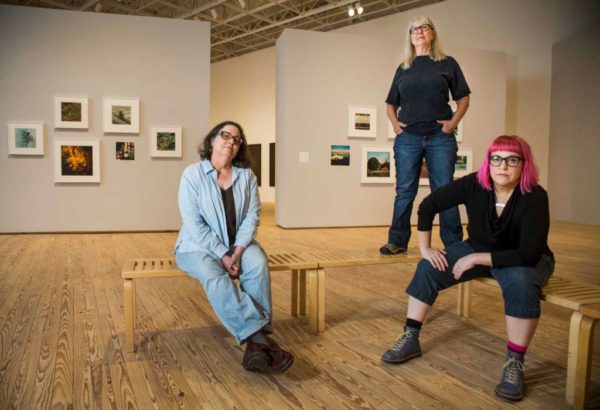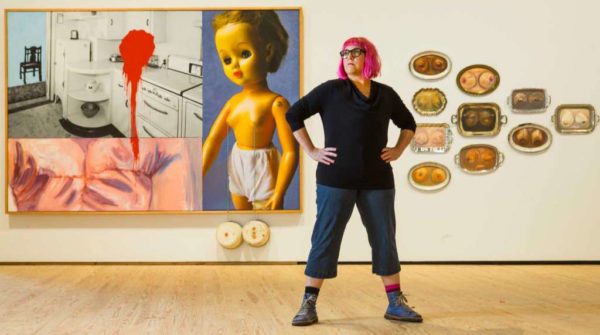Excerpted from “Show of force: CAMH spotlights hometown trio in solo retrospectives: Contemporary Arts Museum Houston spotlights hometown trio in solo retrospectives” by Molly Glentzer in the August 26, 2016 edition of the Houston Chronicle
Lady Part Follies
Though Blakemore’s photographs are like whispers, most of the work in Thedra Cullar-Ledford’s first solo museum show is purposefully brazen.
Two sculptural installations in the center of the room are the exception: “Five Thousand Trashy Romance Novels,” from 1997, is a large cube of paperback books topped with a slab of graphite. It honors the artist’s mother, a “brainiac” writer who indulges in romance novels.
“Homage to the American Trucker,” from Cullar-Ledford’s grad-school years in London, contains a pair of boxes lined with maps and decorated with cutouts based on the familiar “trucker girl” mudflap design.
Each holds an object of clothing – worn work boots and a pair of blue jeans – like a religious relic.
The eyes go first, however, to Cullar-Ledford’s large paintings and mixed-media works, which for the past three years have been born from her experience with breast cancer and a double mastectomy.
The artist knows her recent work, full of scar and nipple images, won’t appeal to everyone. “I don’t want to make art for people who are educated about art,” she said.
Arning called it “the most life-affirming, humorous, politically angry work about cancer” he’s ever seen.
Diving into the local art scene when he arrived in Houston about a decade ago, Arning came to know Cullar-Ledford as a community organizer. She and her husband, Stephen Ledford, built the Independence Heights Studios compound on the north side. They became about as close as it gets to being family without being family: She discovered she had cancer when she was preparing for elective surgery to donate a kidney to Arning’s life partner.
Born in Abilene, Cullar-Ledford grew up in Mexico and on the Texas border with artistic parents. By 16, she was living alone, in Dallas, so she could attend an arts high school. She met Ledford on her first day at California College of the Arts, and they married during their junior year.
When a professor sniped that she’d drop art because she’d be too busy making babies, she responded, defiantly, with a strip-tease performance as a domestic character who was half ladybug.
During their years in London, New York and elsewhere, she and Ledford had two sons, who are now 22 and 15. The family settled in Houston about a decade ago because she wanted chickens, tomatoes and space.
“I’m very happy,” Cullar-Ledford said.
But she’s kept an edge in her art. In 2010, she played with grotesque body imagery in the 50 paintings of her “Dolls” series, a few of which are in the museum show.
“It was a great way to talk about issues I found important,” she said.
Arning interprets that body of work “almost like a rehearsal” for the work Cullar-Ledford made after her surgery, when she made herself get off the couch every day to paint, full of anger.
“I made myself do it because there are ladies that – I always think of them as the choir directors in middle America – who can’t … get up and be mad,” she said. “As soon as I grasped that – that I had a vision and a voice and a calling – it made it easier. It’s like I’m doing this for a bigger cause.”
Her newest works are massive mixed-media collages that combine photographs, paint splatters, painted sections and funny add-ons, such as a pair of suggestively shaped cake-pan lids that hang from long chains.
“I’ve always just said I’m a conceptual artist who uses paint. But now I’ve quit fighting that,” Cullar-Ledford said. “This is all therapy.”
